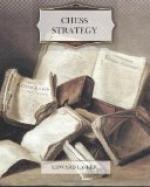the exchange to the good, for the Rook has no file which could be used to break into the Black camp.
In Diagram 14, the numerical equality of forces will not save Black, because bad development reduces the mobility of his pieces to such an extent that he has no resources with which he can parry the impending attack.
--------------------------------------- 8 | | | #K | #R | | #B | | #R | |---------------------------------------| 7 | | #B | | | #Q | #P | #P | #P | |---------------------------------------| 6 | #P | #P | | #P | | | #Kt| | |---------------------------------------| 5 | | | #P | ^P | #P | | | | |---------------------------------------| 4 | | | ^P | | ^P | | | | |---------------------------------------| 3 | | ^P | ^Kt| | ^B | ^Kt| ^P | | |---------------------------------------| 2 | ^P | | | ^Q | | ^P | ^K | ^P | |---------------------------------------| 1 | ^R | | | | ^R | | | | --------------------------------------- A B C D E F G H
Diag. 14
White will assail the Black King’s position on the Queen side, and Black is unable to concentrate his forces quickly enough for the defence of the jeopardised entrenchments. Let us therefore bear in mind that the mobility of the pieces is the deciding factor of their efficiency, and that mobility is the highest criterion by which to judge the merits (or demerits) of their operations.
We will now consider this principle in its application to the three stages of play, namely, the opening, the middle-game, and the ending.
CHAPTER IV
THE OPENING
The only pieces available on the first move are the Knights. In order to develop other pieces as well, it is necessary to move pawns first, and such pawn moves will be best as give an outlet to as many pieces as possible. For quick development is of the utmost importance, and he who succeeds first in placing all his pieces, from their initial awkward positions, to such places as give them command of the greatest possible number of squares, has the better chance of concentrating a superior force on some important point.
It follows that White, having the first move, is, so to speak, always morally justified in attacking, whilst Black should assume the defensive. It is a step in the right direction, to appreciate the truth of this proposition. Unfortunately most beginners fail to realise it, and so pave the way, from the first, to the loss of the game.
There are not many developing pawn moves to choose from. Apparently from the point of view of quick development only P-K4 and P-Q4 need be considered, since they free both Bishop and Queen, whilst other pawn moves liberate one piece only. Generally speaking it is only required to move two or three pawns to allow all pieces to be developed, and it is good, on principle, to make only such pawn moves in the opening, which are necessary for the development of pieces. To play other pawns really means the loss of a move. To “lose a move” means to make a move which is not essential to the attainment of a desired position. Thus the “loss of a move” results also from playing a piece to a given square in more moves than necessary.




